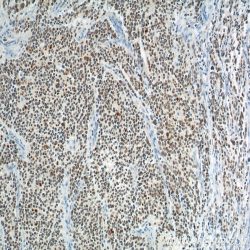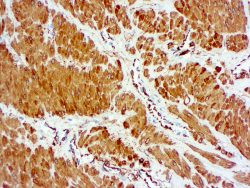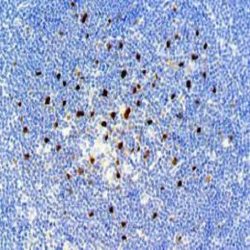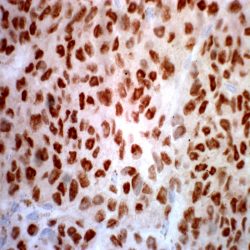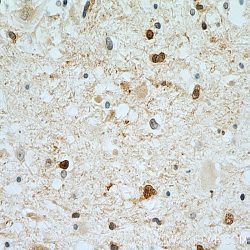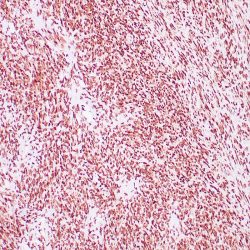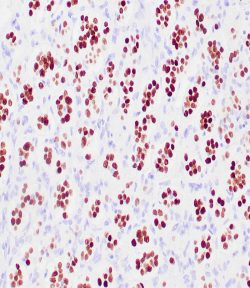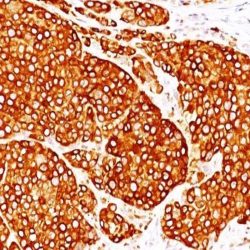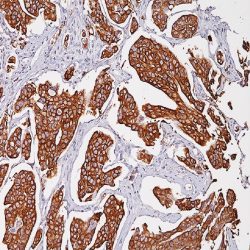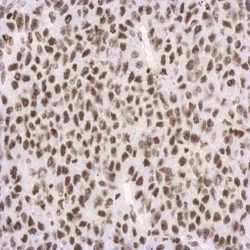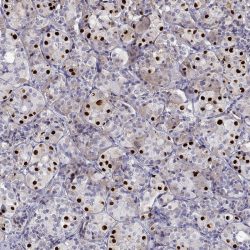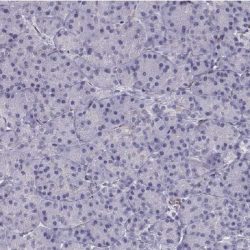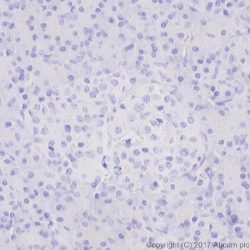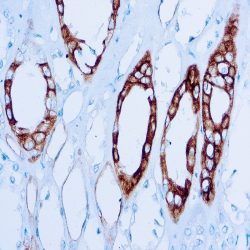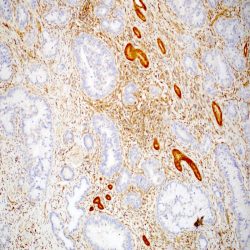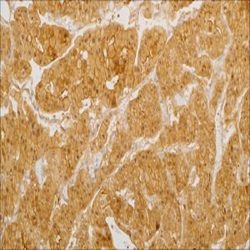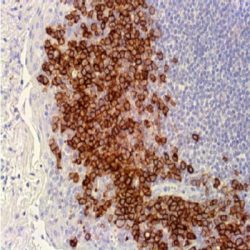دسته: آنتی بادیهای ایمونوهیستوشیمی
نمایش 321–340 از 923 نتیجه
فیلتر ها-
آنتی بادیهای ایمونوهیستوشیمی
آنتی بادی PHOX2B (Paired Mesoderm Homeobox Protein 2B) (EP312)
نمره 0 از 5Name: Rabbit anti-human PHOX2B Monoclonal Antibody (Clone EP312)
Description and aplications: The PHOX2B gene (also known as PMX2B or NBPHOX) is located in the chromosome region 4p13 and encodes a nuclear transcription factor that, during the embryonic development, predominantly expresses in the autonomic nervous system, being essential in the differentiation and survival of vegetative neurons and chromaffin cells. Mutations of the PHOX2B gene are responsible for the central hypoventilation syndrome, a syndrome with autosomal dominant transmission in which the hypoventilation is secondary to the reduction or absence of ventilatory response to hypercapnia or progressive hypoxemia and, as a consequence, new born die during sleep. By definition, there must not be specific neuromuscular diseases of the central nervous system; metabolic, lung, heart diseases or other lesions that explain hypercapnia. This syndrome is associated with tumors of neural crest origin, including neuroblastoma, as well as Hirschsprung’s disease because of the lack of development of the vegetative neurons of the myenteric plexuses.
Composition: Anti-human PHOX2B rabbit monoclonal antibody purified from culture supernatant, filtered, sterilized
and prepared in 10mM PBS, pH 7.4, with 0.2% BSA and 0.09% sodium azide
Immunogen: Synthetic peptide corresponding to the human PHOX2B.
-
آنتی بادیهای ایمونوهیستوشیمی
آنتی بادی Smooth Muscle Actin (1A4)
نمره 0 از 5Name: Mouse anti-human Smooth Muscle Actin (SMA) Monoclonal Antibody (Clone 1A4)
Description and aplications: Actin is a major component of the cytoskeleton and is present in every cell type. Actin can be resolved on the basis of its isoelectric points into three distinctive components: alpha, beta, and gamma in order of increasing isoelectric point. Anti-Smooth Muscle Actin antibody does not stain cardiac or skeletal muscle;
however, it will stain myofibroblasts and myoepithelial cells. This antibody could be used together with Muscle Specific Actin to distinguish leiomyosarcoma from rhabdomyosarcoma. In most cases of rhabdomyosarcoma, this antibody gives negative results whereas Muscle Specific Actin is positive in the rhabdomyoblasts. Leiomyosarcomas are positive with both Muscle Specific Actin and Smooth Muscle Actin antibodies.Composition: Anti-human SMA mouse monoclonal antibody purified from serum and prepared in 10mM PBS, pH
7.4, with 0.2% BSA and 0.09% sodium azide
Immunogen: N-Terminal decapeptide of alpha smooth muscle isoform of actin; acetylated at the Nterminus.
-
آنتی بادیهای ایمونوهیستوشیمی
آنتی بادی SOX 9 (EP317)
نمره 0 از 5Name: Rabitt anti-human SOX9 Antibody (Clon EP317)
Description and aplications: SOX9 is a nuclear transcription factor involved in the differentiation of the chondrocytes and the skeleton as well as of sexual development. The factor is encoded by the gene with the same name located in the chromosome region 17q24.3. This gene encodes a peptide consisting of 509 amino acids containing a
domain homologous to SRY. The co-expression of the genes SOX9 and COL2A1 as well as the overexpression of the first, which is induced by the fibroblast growth factor of primordial chondrocytes, intervenes in the differentiation into mature chondrocytes. About the latter ones, SOX9 interacts additionally with the parathyroid hormone related protein (PTHRP) and helps in keeping its phenotype, inhibiting maturation of hypertrophic chondrocytes. In the determination of the sex of the product of fertilization, SOX9 intervenes together with the steroidogenic factor 1 (SF-1), most probably through SRY gene, functioning as an essential factor in the differentiation of Sertoli cells. The transient activation of the SRY gene of the Y chromosome initializes a set of interactions leading to the formation of the testicle from the undifferentiated gonad; so SOX9 plays a crucial role in this pathway. In fact, the SOX9 gene is overexpressed during the activation of the SRY gene with transfer of its protein from a cytoplasmic to a nuclear location. In contrast, in the female gonad, the SOX9 gene is regulated downwards.Composition: anti-human SOX9 rabbit monoclonal antibody purified from serum and prepared in 10mM PBS, pH 7.4, with 0.2% BSA and 0.09% sodium azide
-
آنتی بادیهای ایمونوهیستوشیمی
آنتی بادی SOX-10 (EP268)
نمره 0 از 5Name: Rabbit anti-human SOX-10 Monoclonal Antibody (Clone EP268)
Description and aplications: SOX10 is a member of the SOX (SRY-related HMG-box) family of transcription factors involved in the regulation of embryonic development and in the determination of cell fate. During development, SOX10 first appears in the forming neural crest and continues to be expressed in Schwann cells. It is important for differentiation, maturation and maintenance of Schwann cells and melanocytes. In normal tissues, SOX10 is expressed in Schwann cells and glial cells in the nervous system. It is also detected in melanocytes and epithelial cells of salivary gland and mammary gland. In tumor tissues, SOX10 labels melanoma and the tumor of neural crest origin. A recent study reported the expression of SOX10 in basal-like, unclassified triple-negative breast carcinoma. Thus, breast carcinoma must be considered in the differential diagnosis of melanoma for a SOX10-positive metastatic malignant neoplasm.
Composition: Anti-human SOX-10 rabbit monoclonal antibody purified from serum and prepared in 10mM PBS, pH 7.4, with 0.2% BSA and 0.09% sodium azide
Immunogen: A recombinant fragment corresponding to residues in human SOX10 protein.
-
آنتی بادیهای ایمونوهیستوشیمی
آنتی بادی Stathmin 1 (STMN1) (SP49)
نمره 0 از 5Name: Rabbit Anti-Human Stathmin 1 (STMN1) Monoclonal Antibody (Clone SP49)
Description and aplications: Stathmin 1 [also known as leukemia-associated phosphoprotein p18 (LAP18), metablastin or OP18] is a cytosolic protein of 18kDa involved in the regulation of the filament system of micotubules (MTs), destabilizing them after the sequestration of molecules of the tubulin. Its production is coded by the STM1 gene located in the chromosome region 1p36.11. The protein prevents the assembly and supports the disassembly of microtubules. Ser-16 phosphorylation might be necessary to form axons during neurogenesis. Furthermore, many different phosphorylated forms can be observed depending on specific combinations among the locations that can be phosphorylated. MAPK is responsible for the phosphorylation of the stathmin in response to NGF. Ser-16 phosphorylation seems to be necessary for the polarization of neurons (by similarity). Ser-63 phosphorylation reduces 10-fold the binding of tubulin and suppresses the inhibition of the polymerization of the MTs. It is involved in the control of the learned and innate fear.
Composition: anti-Stathmin 1 rabbit monoclonal antibody obtained from supernatant culture and prediluted in a tris buffered solution pH 7.4 containing 0.375mM sodium azide solution as bacteriostatic and bactericidal.
Immunogen: Synthetic peptide among the amino acids 1 to 100 of the C-terminal subunit of the human Stathmin 1
-
آنتی بادیهای ایمونوهیستوشیمی
آنتی بادی STAT6 (EP325)
نمره 0 از 5Name: Rabbit anti-human STAT6 Monoclonal Antibody (Clone EP325)
Description and aplications: Signal transducer and activator of transcription 6 (STAT6) is a member of the STAT family, which encompasses several cytoplasmic transcription factors that are responsible for the transmission of the activation signals induced by several cytokines and cell growth factors to the nucleus. Specifically, the STAT6 molecule is essential in the Jak/STAT transduction pathway, where it is responsible for regulating the signal that controls embryonic
development, the regulation of cell differentiation and apoptosis and certain aspects of the immune adaptive response, essentially the secretion of interleukins 3 and 4. The nuclear or cytoplasmic expression of STAT6 is a useful marker to distinguish the solitary fibrous tumor from other soft tissue neoplasms.Composition: Anti-human STAT6 rabbit monoclonal antibody purified from culture supernatant, filtered, sterilized and prepared in 10mM PBS, pH 7.4, with 0.2% BSA and 0.09% sodium azide
Immunogen: Synthetic peptide corresponding to the human STAT6.
-
آنتی بادیهای ایمونوهیستوشیمی
آنتی بادی SF1 – FACTOR 1 ESTEROIDOGÉNICO (N1665)
نمره 0 از 5Name: Mouse anti-Steroidogenic Factor 1 Monoclonal Antibody (clone N1665)
Description and aplications: Steroidogenic factor 1 (SF-1), also known as Ad4BT (adrenal 4 binding protein) or NR5A1 (nuclear receptor subfamily, group 5, member 1) is a transcription factor that belongs to the nuclear receptor superfamily and functions as a key regulator in the development and function of the adrenal gland and the male reproductive system after the enzymatic control of the biosynthesis of corticosteroids and aldosterone. It also intervenes at pituitary level for the development of the gonads. SF-1 is encoded by the NR5A1 gene, located in the region q33 of chromosome 9. It is a gene of 22kb containing 7 exons. Mutations of the gene are responsible for the development of dysgenetic gonads and ovarian insufficiency in women or female gonads or ambiguous gonads in men. It is also responsible for the absence of puberty and infertility, especially in men.
Composition: Mouse anti-Steroidogenic Factor 1 (SF1) monoclonal antibody obtained from purified ascitic fluid and prepared in 10mM PBS, pH 7.4, with 0.2% BSA and 0.09% sodium azide.
-
آنتی بادیهای ایمونوهیستوشیمی
آنتی بادی Thyrosinase (T311)
نمره 0 از 5Name: Mouse anti-human Tyrosinase Monoclonal Antibody (Clone T311)
Description and aplications: Melanin synthesis by melanocytes comprises a cascade of reactions involving a family of enzymes. One of the key enzymes is tyrosinase. L-tyrosine is the initial substrate for melanin synthesis and its conversion to dopaquinone is catalysed by tyrosinase, the expression of which is therefore a marker of melanocytes and melanoma.
Tyrosinase deficiency is associated with various forms of albinism, specially oculocutaneous albinism. This antibody is useful for the identification of melanocytic tumours and it may be used in combination with other markers such as Melan A. Both markers are expressed in 80-100% of melanoma cases.Composition: Anti-human Tyrosinase mouse monoclonal antibody purified from serum and prepared in 10mM PBS, pH
7.4, with 0.2% BSA and 0.09% sodium azide
Immunogen: Recombinant protein corresponding to the tyrosinase molecule.
-
آنتی بادیهای ایمونوهیستوشیمی
آنتی بادی Uroplakin II (BC21)
نمره 0 از 5Name: Mouse Anti-Human Uroplakin II Monoclonal Antibody (Clone BC21)
Description and aplications: Uroplakin II (UP2) is a membrane-specialized protein of 15kDa that, along with the Uroplakins 1A, 1B and 3, compose the asymmetric membrane unit located in the apical cell plates of the human urothelium. UP2 is synthesized by urothelial cells in the final stage of differentiation. The synthesis of the protein is coded by the UPK2 gene located in the chromosome region 11q23.3. In normal tissues, the antibody specifically recognizes the UP2 in the surface layers of the normal urothelium, being negative in the rest of the human epithelia.
Composition: anti-Uroplakin 3 mouse monoclonal antibody obtained from supernatant culture and prediluted in a tris buffered solution pH 7.4 containing 0.375mM sodium azide solution as bacteriostatic and bactericidal.
Immunogen: Residues corresponding to amino acids 3650 of the human Uroplakin II
-
آنتی بادیهای ایمونوهیستوشیمی
آنتی بادی – H3K27me3 (Lys27) (clone C36B11)
نمره 0 از 5Name: Rabbit Anti-Human H3K27me3 (Lys27) Monoclonal Antibody (Clone C36B11)
Description and aplications: The nucleosome, which consists of four core histone proteins (H2A, H2B, H3 and H4), is the main component of chromatin. Originally thought to function as a static scaffold for DNA packaging, histones have subsequently been shown to be dynamic proteins, undergoing multiple types of posttranslational modifications, including acetylation, phosphorylation, methylation, and ubiquitination. Histone methylation is a fundamental determinant for
the formation of active and inactive regions of the genome and is crucial for their proper programming during embryonic development. Arginine methylation of histones H3 (Arg2, 17, 26) and H4 (Arg3) promotes transcriptional activation and is mediated by a family of arginine methyltransferase (PRMT)-like proteins, including the coactivators PRMT1 and CARM1(PRMT4). In contrast, a more diverse set of lysine methyltransferase-type histones has been identified, among which all but one contains a conserved catalytic SET domain, and that was originally identified in the Zeste and Trithorax regulatory proteins of the fly Drosophila Su (var) 3-9. Lysine methylation occurs primarily at histones H3 (Lys4, 9, 27, 36, 79) and H4 (Lys20) and has been implicated in both transcriptional activation and gene silencing. Additionally, methylation of these lysine residues coordinates the recruitment of chromatinmodifyinenzymes containing methyl lysine binding modules, either as chromodomains (HP1, PRC1), PHD fingers (BPTF, ING2), Tudor domains (53BP1) and WD-40 domains (WDR5). Finally, the discovery of histone demethylases such as PADI4, LSD1, JMJD1, JMJD2 and JHDM1 has demonstrated that methylation is a reversible epigenetic marker. NF1 mutations and inactivation of CDKN2A are found
in most malignant peripheral nerve sheath tumors (TMVNP), where inactivation of CDKN2A is an early event during their development, occurring in the course of progression from conventional to atypical neurofibroma. Furthermore, inactivation of the polycomb repressive complex 2 (PRC2) resulting from mutually exclusive mutations of its SUZ12 or
EED1 portions has recently been identified in 70-90% of TMVNPs. In this regard, inactivation of PRC2 leads to loss of trimethylation at histone H3 lysine 27 (H3K27me3).Composition: Anti-human H3K27me3 (Lys27) rabbit polyclonal antibody obtained from ascitic fluid and prepared in 10mM PBS, pH 7.4, with 0.2% BSA and 0.09% sodium azide.
Immunogen: Synthetic peptide corresponding to the terminal amino acids of human histone 3 in which Lys27 is trimethylated.
-
آنتی بادیهای ایمونوهیستوشیمی
آنتی بادی T-PIT/TBX19 (polyclonal)
نمره 0 از 5Name: Rabbit Anti-Human T-PIT/TBX19 Polyclonal Antibody
Description and aplications: The TPIT molecule, also known as T-Box 19 or TBX19, is a gene transcription factor of the T-box gene family that is mainly involved in the regulation of embryonic development. In the case of TPIT, whose coding gene consists of 8 exons and is located in the chromosomal region 1q24.2, its expression is restricted to the two pituitary cell lines (corticotroph and melanotroph), in which it activates the POMC gene responsible for the secretion of proopiomelanocortin. This molecule, and its derivative opiomelanocortin, are the precursors of ACTH synthesis as well as of some molecules related to appetite regulation, mainly lipotropin beta.
Composition: Anti-human T-PIT/TBX19 rabbit polyclonal antibody obtained from ascitic fluid and prepared in 10mM PBS, pH 7.4, with 0.2% BSA and 0.09% sodium azide.
Immunogen: Recombinant protein corresponding to human T-PIT/TBX19.
-
آنتی بادیهای ایمونوهیستوشیمی
آنتی بادی PIT-1/POU1F1 (polyclonal)
نمره 0 از 5Name: Rabbit Anti-Human PIT-1/POU1F1 Polyclonal Antibody
Description and aplications: The PIT-1 molecule (pituitary-specific transcription factor 1, also known as POU1F1 or GHF-1) belongs to the POU group of transcription factors involved in development together with OCT1 and Unc-06. It is
encoded by a gene located on chromosomal region 3p11.2. PIT-1 is involved in the differentiation and development of anterior pituitary cells, secreting hormones with lactotropic, somatotropic and
thyrotropic activity (beta subunit). It is also involved in the activation of genes controlling growth hormones and prolactin. Heterogeneous (homo- and heterozygous) mutations of PIT-1 lead to combined pituitary deficiency type 1 which is clinically characterized by irreversible mental and growth retardation and presents deficient plasma levels of growth hormone, combined mainly with low levels of prolactin or TSH. In contrast, ACTH, LH or FSH levels remain within normal values in this disease. Acquired combined pituitary deficiency has also been described, in which patients do not have mutations of the PIT-1 gene but nevertheless have low plasma levels of free TSH and free T4 along with undetectable levels of growth hormone and prolactin. In these cases, the disease is associated with the presence of autoantibodies to PIT-1, microsomes, thyroglobulin, thyroid peroxidase, GAD, and parietal cells of the stomach. PIT-1 staining of pituitary adenomas is similar to that of the normal gland. Although PIT-1 is not routinely used to characterize these neoplasms, in the case of non-functioning adenomas that have tested negative for the first panel of antibodies of
pituitary hormones, the combined use of PIT-1, T-PIT and SF-1 antibodies can differentiate PIT-1-positive adenomas from true null adenomas.
Composition: Anti-human PIT-1/POU1F1 rabbit polyclonal antibody obtained from ascitic fluid and prepared in 10mM PBS, pH 7.4, with 0.2% BSA and 0.09% sodium azide.
Immunogen: Recombinant protein corresponding to human PIT-1/POU1F1.
-
آنتی بادیهای ایمونوهیستوشیمی
آنتی بادی PRAME 1 (EPR20330)
نمره 0 از 5Name: Rabbit Anti-Human PRAME 1 Monoclonal Antibody (Clone EPR20330)
Description and aplications: The PReferentially expressed Antigen in MElanoma (PRAME), or LB33-E antigen, is part of the family of melanoma nuclear proteins recognized by cytolytic T lymphocytes and is encoded by a gene of the same
name (PRAME) located on chromosomal region 22q11.22. The PRAME protein has been characterized as a dominant inhibitor of the retinoic acid receptor, thus participating in the blockade of cell proliferation, differentiation or apoptosis induced by retinoic acid through the RARA, RARB and RARG receptors. Thus, overexpression of PRAME in tumor cells confers a survival advantage over normal cells. In melanomas, PRAME inhibition restores retinoic acid signaling an reinstates the sensitivity of tumor cells to the antiproliferative effects of this molecule.Composition: Anti-human PRAME 1 rabbit monoclonal antibody obtained from ascitic and prepared in 10mM PBS, pH 7.4, with 0.2% BSA and 0.09% sodium azide.
Immunogen: N/A
-
آنتی بادیهای ایمونوهیستوشیمی
آنتی بادی Renal cell carcinoma marker (PN-15)
نمره 0 از 5Name: Mouse anti- Human Renal cell carcinoma marker (PN-15) Monoclonal Antibody
Description and aplications:This antibody detects the membrane glycoprotein gp200. In a normal kidney, gp200 is located along the brush border of the contoured and straight segments of the proximal tubule, as well as focally along the luminal surface of Bowman’s capsule, contiguous with the exit of the proximal tubule. Gp200 is also located on the luminal surface of the mammary ducts and lobes and the tubular epithelium of the epididymis, in the cytoplasm of parathyroid and parenchymal cells, and focally within the colloid of thyroid follicles.
Composition: Anti-human renal cell carcinoma marker (PN-15) mouse monoclonal antibody purified and prepared in 10mM PBS, pH 7.4, with 0.2% BSA and 0.09% sodium azide.
Immunogen: Microsomal fraction of human renal cortical tissue homogenate.
-
آنتی بادیهای ایمونوهیستوشیمی
آنتی بادی SMAD4/Dpc4 (B8)
نمره 0 از 5Name: Mouse Anti-Human SMAD4/Dpc4 Monoclonal Antibody (Clone B8)
Description and applications: The Mothers Against Decapentaplegic homolog 4(SMAD4) protein, also known as MADH4, MANrelatedprotein 4, MAD, pancreatic carcinoma deletion factor 4 or DPC4, is linked to the SMAD4 suppressor gene, which consists of 11 exons, and is located in the genomic region 18q21.1. This gene shows allelic or biallelic loss in 50% of pancreatic carcinomas
Composition: Anti-human SMAD4/Dpc4 mouse monoclonal antibody obtained from ascitic fluid and prepared in 10mM PBS, pH 7.4, with 0.2% BSA and 0.09% sodium azide
Immunogen: N/A -
آنتی بادیهای ایمونوهیستوشیمی
آنتی بادی Parvalbumin (EP300)
نمره 0 از 5NAME: Rabitt anti-Parvalbumin Antibody (Clon EP300)
Description and applications: Parvalbumin is a protein with wide calcium-ionbinding affinity and thus intervenes in its cytosolic homeostasis. The PVALB gene, which encodes the production of this protein, is located in the chromosome region 22q12.3 and shows structural and functional similarities with the one of the Calmodulin and Troponin C, whose coding genes constitute a superfamily.
Composition: anti-human Parvalbumin rabbit monoclonal antibody purified from serum and prepared in 10mM PBS, pH 7.4, with 0.2% BSA and 0.09% sodium azide
-
آنتی بادیهای ایمونوهیستوشیمی
آنتی بادی CD38 (CD38/4328)
نمره 0 از 5Name: CD38 Antibody Clone CD38/4328
Description and applications: CD38 is a single chain type II integral transmembrane protein, which is
highly expressed on thymocytes. It is also present on activated T cells and terminally differentiated B cells
(plasma cells). Other reactive cells include NK cells, monocytes, macrophages, and dendritic cells. CD38
may be detected on cells from multiple myeloma, ALL (B and T) and some AML. It is, however, not found on most mature resting peripheral lymphocytes. CD38 functions as a multicatalytic ectoenzyme serving as
ADP-ribosyl cyclase, cyclic ADP-ribose hydrolase and possibly NAD+ glycohydrolase or as a cell surface receptor.Composition: Anti-human CD38 mouse monoclonal antibody purified from serum and prepared in 10mM PBS, pH 7.4, with 0.2% BSA and 0.09% sodium azide.
Immunogen: Recombinant full-length human CD38 protein.
-
آنتی بادیهای ایمونوهیستوشیمی
آنتی بادی CD38 کلون 38C03 برند Vitro
نمره 0 از 5Name: CD38 Monoclonal Antibody clone 38C03
DESCRIPTION AND APPLICATIONS: CD38 is a single chain type II integral transmembrane protein, which is highly expressed on thymocytes. It is also present on activated T cells and terminally differentiated B cells (plasma cells). Other reactive cells include NK cells, monocytes, macrophages, and dendritic cells. CD38 may be detected on cells from multiple myeloma, ALL (B and T) and some AML. It is, however, not found on most mature resting peripheral lymphocytes. CD38 functions as a multicatalytic ectoenzyme serving as ADP-ribosyl cyclase, cyclic ADP-ribose hydrolase and possibly NAD+ glycohydrolase or as a cell surface receptor. Antibodies to CD38 are useful in subtyping of lymphomas and leukemias, detection of plasma cells (i.e. identification of myelomas), and as a marker for activated B and T cells.
COMPOSITION: Anti-human CD38 mouse monoclonal antibody purified from serum and prepared in 10mM PBS, pH 7.4, with 0.2% BSA and 0.09% sodium azide
INTENDED USE: Immunohistochemistry (IHC) on paraffin embedded tissues. Not tested on frozen tissues or Western-Blotting
IMMUNOGEN: Recombinant protein encoding the extracellular domain of human CD38.
SPECIES REACTIVITY: In vitro diagnostics in humans. Not tested in other species
-
آنتی بادیهای ایمونوهیستوشیمی
آنتی بادی CD45 کلون 2B11 & PD7/26 برند Vitro
نمره 0 از 5Name: CD38 Monoclonal Antibody clone 2B11 & PD7/26
DESCRIPTION AND APPLICATIONS: Anti-CD45 (anti leukocyte common antigen) is routinely used to aid the differential diagnosis of undifferentiated neoplasms, whenever malignant lymphoma is suspected by the morphological or clinical data. It is a highly specific antibody; therefore a positive result is highly indicative of hematolymphoid origin. Certain types of hematolymphoid neoplasms may lack CD45(Hodgkin lymphoma, some T-cell lymphomas, and some leukemias) so its absence does not rule out a hematolymphoid tumor. This antibody is expressed almost exclusively by cells of hematopoietic lineage and is present in most benign and malignant lymphocytes as well as plasma cell precursors.
COMPOSITION: Anti-human CD45, also known as leukocyte common antigen, is a mouse monoclonal antibody purified from serum and prepared in 10mM PBS, pH 7.4, with 0.2% BSA and 0.09% sodium azide
INTENDED USE: Immunohistochemistry (IHC) on paraffin embedded tissues. Not tested on frozen tissues or Western-Blotting
SPECIES REACTIVITY: In vitro diagnostics in humans. Not tested in other species
-
آنتی بادیهای ایمونوهیستوشیمی
آنتی بادی CD42b کلون EPR19204 برند Vitro
نمره 0 از 5Name: CD42b Monoclonal Antibody clone EPR19204
DESCRIPTION AND APPLICATIONS: The CD42b glycoprotein, also known as GPIb, is a co-factor of ristocetin-induced aggregation and is involved in the binding of platelets to blood vessel walls. The CD42b antigen is expressed on platelets and on megakaryocytes in bone marrow. The absence of CD42b antigen on platelets may indicate Bernard Soulier disease. The antibody is of value in theimmunophenotyping of megakaryoblastic leukaemias that express one or more markers associated with platelets (CD41, CD61 and CD42b). In chronic myeloproliferative processes, like chronic idiopathic myelofibrosis in prefibrotic stage besides appearing in greater numbers the megakaryocytes are markedly abnormal while megakaryocytes in unclassifiable myelodysplastic / myeloproliferative diseases there is an increased of normal or small megakaryocytes (micromegakaryocytes).
COMPOSITION: Anti-human CD42b rabbit monoclonal antibody purified from hybridoma and, diluted in a pH7.6 buffer containing stabilizing protein and sodium azide as bacteriostatic and bactericidal agent.
INTENDED USE: Immunohistochemistry (IHC) on paraffin embedded tissues. Not tested on frozen tissues or Western-Blotting
IMMUNOGEN: Recombinant CD42b.
SPECIES REACTIVITY: In vitro diagnostics in humans. Not tested in other species

